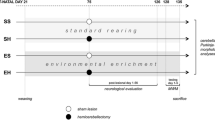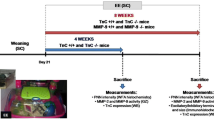Abstract
Recent findings suggest marked interconnections between the cerebellum and striatum, thus challenging the classical view of their segregated operation in motor control. Therefore, this study was aimed at further investigating this issue by analyzing the effects of hemicerebellectomy (HCb) on density and dendritic length of striatal fast-spiking interneurons (FSi). First, we analyzed the plastic rearrangements of striatal FSi morphology in hemicerebellectomized animals reared in standard conditions. Then, since environmental enrichment (EE) induces structural changes in experimental models of brain disease, we evaluated FSi morphology in lesioned animals exposed to an enriched environment after HCb. Although HCb did not affect FSi density, it progressively shrank dendritic branching of striatal FSi of both sides. These plastic changes, already evident 15 days after the cerebellar ablation, became very marked 30 days after the lesion. Such a relevant effect was completely abolished by postoperative enrichment. EE not only counteracted shrinkage of FSi dendritic arborization but also provoked a progressive increase in dendritic length which surpassed that of the controls as the enrichment period lengthened. These data confirm that the cerebellum and striatum are more interconnected than previously retained. Furthermore, cerebellar damage likely evokes a striatal response through cortical mediation. The EE probably modifies HCb-induced plastic changes in the striatum by increasing the efficiency of the cortical circuitry. This is the first study describing the morphological rearrangement of striatal FSi following a cerebellar lesion; it provides the basis for further studies aimed at investigating the mechanisms underlying cerebello-striatal “talking.”



Similar content being viewed by others

References
Friston KJ, Frith CD, Passingham RE, Liddle PF, Frackowiak RS. Motor practice and neurophysiological adaptation in the cerebellum: a positron tomography study. Proc Biol Sci. 1992;248:223–8.
Jenkins IH, Brooks DJ, Nixon PD, Frackowiak RS, Passingham RE. Motor sequence learning: a study with positron emission tomography. J Neurosci. 1994;14:3775–90.
Seitz RJ, Canavan AG, Yágüez L, Herzog H, Tellmann L, Knorr U, et al. Successive roles of the cerebellum and premotor cortices in trajectorial learning. Neuroreport. 1994;5:2541–4.
Jueptner M, Frith CD, Brooks DJ, Frackowiak RS, Passingham RE. Anatomy of motor learning. II. Subcortical structures and learning by trial and error. J Neurophysiol. 1997;77:1325–37.
Toni I, Krams M, Turner R, Passingham RE. The time course of changes during motor sequence learning: a whole-brain fMRI study. Neuroimage. 1998;8:50–61.
Laforce Jr R, Doyon J. Distinct contribution of the striatum and cerebellum to motor learning. Brain Cogn. 2001;45:189–211.
Laforce Jr R, Doyon J. Differential role for the striatum and cerebellum in response to novel movements using a motor learning paradigm. Neuropsychologia. 2002;40:512–7.
Garraux G, McKinney C, Wu T, Kansaku K, Nolte G, Hallett M. Shared brain areas but not functional connections controlling movement timing and order. J Neurosci. 2005;25:5290–7.
Elsinger CL, Harrington DL, Rao SM. From preparation to online control: reappraisal of neural circuitry mediating internally generated and externally guided actions. Neuroimage. 2006;31:1177–87.
Grafton ST. Cortical control of movement. Ann Neurol. 1994;36:3–4.
Middleton FA, Strick PL. Basal-ganglia 'projections' to the prefrontal cortex of the primate. Cereb Cortex. 2002;12:926–35.
Ichinohe N, Mori F, Shoumura K. A di-synaptic projection from the lateral cerebellar nucleus to the laterodorsal part of the striatum via the central lateral nucleus of the thalamus in the rat. Brain Res. 2000;880:191–7.
Hoshi E, Tremblay L, Féger J, Carras PL, Strick PL. The cerebellum communicates with the basal ganglia. Nat Neurosci. 2005;8:1491–3.
Centonze D, Rossi S, De Bartolo P, De Chiara V, Foti F, Musella A, et al. Adaptations of glutamatergic synapses in the striatum contribute to recovery from cerebellar damage. Eur J Neurosci. 2008;27:2188–96.
Calabresi P, Mercuri NB, Stefani A, Bernardi G. Synaptic and intrinsic control of membrane excitability of neostriatal neurons. I. An in vivo analysis. J Neurophysiol. 1990;63:651–62.
Kita H. Glutamatergic and GABAergic postsynaptic responses of striatal spiny neurons to intrastriatal and cortical stimulation recorded in slice preparations. Neuroscience. 1996;70:925–40.
Koós T, Tepper JM. Inhibitory control of neostriatal projection neurons by GABAergic interneurons. Nat Neurosci. 1999;2:467–72.
Yoshida M, Nagatsuka Y, Muramatsu S, Niijima K. Differential roles of the caudate nucleus and putamen in motor behavior of the cat as investigated by local injection of GABA antagonists. Neurosci Res. 1991;10:34–51.
Yamada H, Fujimoto K, Yoshida M. Neuronal mechanism underlying dystonia induced by bicuculline injection into the putamen of the cat. Brain Res. 1995;677:333–6.
Krech D, Rosenzweig MR, Bennett EL. Effects of environmental complexity and training on brain chemistry. J Comp Physiol Psychol. 1960;53:509–19.
Krech D, Rosenzweig MR, Bennett EL. Relations between chemistry and problem-solving among rats raised in enriched and impoverished environments. J Comp Physiol Psychol. 1962;55:801–7.
Diamond MC, Law F, Rhodes H, Lindner B, Rosenzweig MR, Krech D, et al. Increases in cortical depth and glia numbers in rats subjected to enriched environment. J Comp Neurol. 1966;128:117–26.
Rosenzweig MR, Bennett EL, Hebert M, Morimoto H. Social grouping cannot account for cerebral effects of enriched environments. Brain Res. 1978;153:563–76.
Rosenzweig MR, Bennett EL. Psychobiology of plasticity: effects of training and experience on brain and behavior. Behav Brain Res. 1996;78:57–65.
Nithianantharajah J, Hannan AJ. Enriched environments, experience-dependent plasticity and disorders of the nervous system. Nat Rev Neurosci. 2006;7:697–709.
Turner CA, Lewis MH, King MA. Environmental enrichment: effects on stereotyped behavior and dendritic morphology. Dev Psychobiol. 2003;43:20–7.
Döbrössy MD, Dunnett SB. Environmental enrichment affects striatal graft morphology and functional recovery. Eur J Neurosci. 2004;19:159–68.
Faherty CJ, Shepherd KR, Herasimtschuk A, Smeyne RJ. Environmental enrichment in adulthood eliminates neuronal death in experimental Parkinsonism. Mol Brain Res. 2005;134:170–9.
Caston J, Devulder B, Jouen F, Lalonde R, Delhaye-Bouchaud N, Mariani J. Role of an enriched environment on the restoration of behavioral deficits in Lurcher mutant mice. Dev Psychobiol. 1999;35:291–303.
Foti F, Laricchiuta D, Cutuli D, De Bartolo P, Gelfo F, Angelucci F, et al. Exposure to an enriched environment accelerates recovery from cerebellar lesion. Cerebellum. 2011;10:104–19.
Gelfo F, Cutuli D, Foti F, Laricchiuta D, De Bartolo P, Caltagirone C, et al. Enriched environment improves motor function and increases neurotrophins in hemicerebellar lesioned rats. Neurorehabil Neural Repair. 2011;25:243–52.
Paxinos G, Watson C. The rat brain in stereotaxic coordinates. 4th ed. San Diego: Academic; 1998.
Abercrombie M. Estimation of nuclear population from microtome sections. Anat Rec. 1946;94:239–47.
Rudkin TM, Sadikot AF. Thalamic input to parvalbumin immunoreactive GABAergic interneurons: organization in normal striatum and effect of neonatal decortication. Neuroscience. 1999;88:1165–75.
Kawaguchi Y. Neostriatal cell subtypes and their functional roles. Neurosci Res. 1997;27:1–8.
Bolam JP, Hanley JJ, Booth PAC, Bevan MD. Synaptic organization of the basal ganglia. J Anat. 2000;196:527–42.
Ramanathan S, Hanley JJ, Deniau J-M, Bolam JP. Synaptic convergence of motor and somatosensory cortical afferents onto GABAergic interneuron’s in the rat striatum. J Neurosci. 2002;22:8158–69.
Tepper JM, Bolam JP. Functional diversity and specificity of neostriatal interneurons. Curr Opin Neurobiol. 2004;14:685–92.
Wellman CL, Sengelaub DR. Alteration in dendritic morphology of frontal cortical neurones after basal forebrain lesions in adult and aged rats. Brain Res. 1995;669:48–58.
Works SJ, Wilson RE, Wellman CL. Age-dependent effect of cholinergic lesion on dendritic morphology in rat frontal cortex. Neurobiol Aging. 2004;25:963–74.
Olney JW. Brain lesions obesity and other disturbances in mice treated with monosodium glutamate. Science. 1969;164:719–21.
Bonfoco E, Krainc D, Ankarcrona M, Nicotera P, Lipton SA. Apoptosis and necrosis: two distinct events induced, respectively, by mild and intense insults with N-methyl-d-aspartate or nitric oxide/superoxide in cortical cell cultures. Proc Natl Acad Sci USA. 1995;92:7162–6.
Bindokas VP, Miller RJ. Excitotoxic degeneration is initiated at non-random sites in cultured rat cerebellar neurons. J Neurosci. 1995;15:6999–7011.
Greenwood SM, Mizielinska SM, Frenguelli BG, Harvey J, Connolly CN. Mitochondrial dysfunction and dendritic beading during neuronal toxicity. J Biol Chem. 2007;282:26235–44.
Paban V, Jaffard M, Chambon C, Malafosse M, Alescio-Lautier B. Time course of behavioral changes following basal forebrain cholinergic damage in rats: environmental enrichment as a therapeutic intervention. Neuroscience. 2005;132:13–32.
Petrosini L, De Bartolo P, Foti F, Gelfo F, Cutuli D, Leggio MG, et al. On whether the environmental enrichment may provide cognitive and brain reserves. Brain Res Rev. 2009;61:221–39.
Leggio MG, Mandolesi L, Federico F, Spirito F, Ricci B, Gelfo F, et al. Environmental enrichment promotes improved spatial abilities and enhanced dendritic growth in the rat. Behav Brain Res. 2005;163:78–90.
Gelfo F, De Bartolo P, Giovine A, Petrosini L, Leggio MG. Layer and regional effects of environmental enrichment on the pyramidal neuron morphology of the rat. Neurobiol Learn Mem. 2009;91:353–65.
Mandolesi L, De Bartolo P, Foti F, Gelfo F, Federico F, Leggio MG, et al. Environmental enrichment provides a cognitive reserve to be spent in the case of brain lesion. J Alzheimers Dis. 2008;15:11–28.
Conflict of Interest
All the authors have approved the manuscript that is enclosed and fully disclose all conflicts of interest.
Author information
Authors and Affiliations
Corresponding author
Additional information
Paola De Bartolo and Francesca Gelfo contributed equally to this work.
Rights and permissions
About this article
Cite this article
De Bartolo, P., Gelfo, F., Burello, L. et al. Plastic Changes in Striatal Fast-Spiking Interneurons Following Hemicerebellectomy and Environmental Enrichment. Cerebellum 10, 624–632 (2011). https://doi.org/10.1007/s12311-011-0275-0
Published:
Issue Date:
DOI: https://doi.org/10.1007/s12311-011-0275-0



